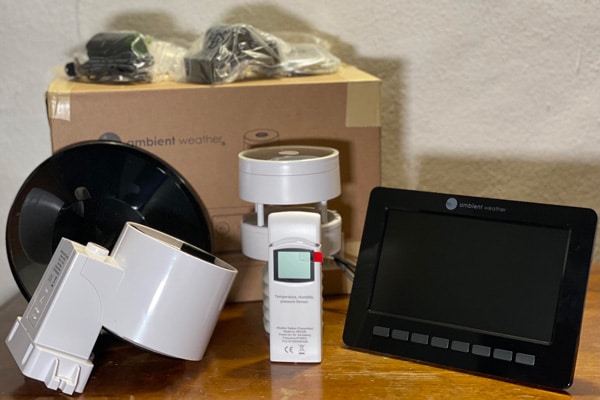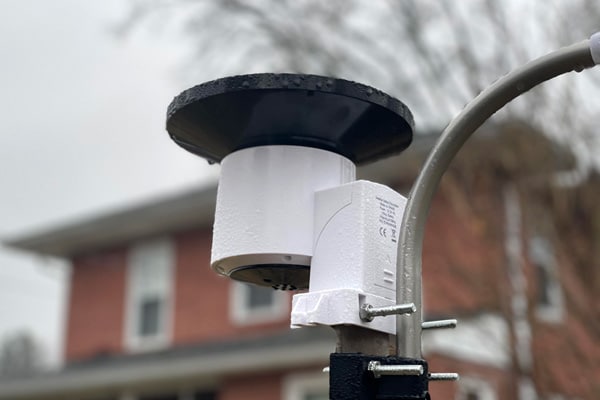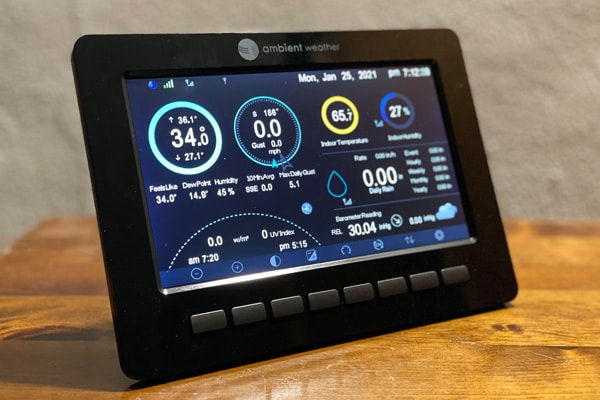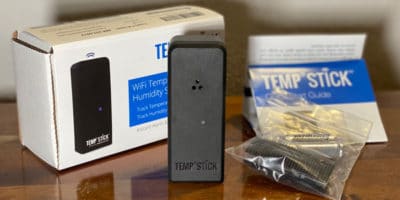In the past, Ambient Weather’s home weather stations solidly occupied the value category. While not the cheapest stations on the market, they were still on the value end of the scale but with better accuracy and durability than the competition in our long-term tests.
Things have progressed for the company. Since our initial review of the WS-2902 back in 2018, Ambient Weather has found a new home. Nielsen-Kellerman acquired Ambient Weather in 2019. Nielsen-Kellerman is behind the award-winning Kestrel handheld weather meters and RainWise, a high-end professional weather station brand used in education and commercial deployments.
The Ambient Weather WS-5000 ultrasonic weather station is the first model developed under new ownership. It picks up a few enhancements along the way, including a redesigned sensor suite, a sonic anemometer, and a drastically better console.
But is the WS-5000’s upgraded construction and functionality just window dressing? Is Ambient Weather ready to compete with higher-end stations? Keep reading our WS-5000 review to find out.
Our team of editors independently research, test, and recommend the best products to help you navigate when shopping online. This post contains compensated links, and if you make a purchase using the links included, we may earn a commission. To learn more, read our disclaimer.
Pros
- Best-in-class feature set
- Tons of optional sensors
- Smart home connectivity (IFTTT, Alexa, Google Assistant)
- A fairly simple install
- Beautiful display with wide viewing angle
Cons
- The console setup process is cumbersome
- Some sensors had to be reset to connect to console
Our Verdict
Don’t let the WS-5000’s quirks scare you away from what is otherwise an outstanding personal weather station. At the moment, we think Ambient Weather’s latest weather station is the closest you’ll get to the Davis Vantage Vue in terms of accuracy, but with far more expandability and a lower price. It’s worth the premium to the WS-2000 and WS-2902C.
Included Instruments
Installation and Setup
The base WS-5000 station package includes the console, an indoor thermometer/hygrometer, and a barometer sensor. A sonic anemometer with an integrated thermometer/hygrometer, a UV and light sensor, and a separate rain gauge. This setup of sensors is adequate for many, but the WS-5000 can also connect with a range of additional sensors.

Unboxing the WS-5000 base package of instruments and the display console.
The optional sensors include:
- Indoor PM2.5 Air Quality Sensor
- Outdoor PM2.5 Air Quality Sensor
- Lightning Detector
- Soil Moisture Sensor
- Waterproof Temperature Probe
- Leak Detector
Unfortunately, it’s winter as of the time of this review, so sensors like lightning and soil moisture were challenging to test. But we were able to try many of them.
Batteries are (mostly) not included with either the base package or any sensors, so be sure that you have any necessary batteries for the sensors you buy before you start. All sensors use ‘AA’ batteries, so have a larger pack handy. Also, be sure to use higher-end lithium batteries—cheap batteries will cause problems.
We followed our recommendations for siting the sensors as best we could and got to work on the setup. It isn’t difficult at all. The instructions are simple to follow, and like other Ambient Weather products we’ve tested, it’s hard to mess up as long as you do it in order.

Our installation of the Ambient Weather WS-5000
We’d expect you to spend more time figuring out where to put your station versus actually putting it together. We completed the entire process in about 45 minutes ourselves, with only a few issues. The console did not detect our indoor temperature sensor or rain gauge initially. However, Ambient Weather has a support document on the topic, which fixed the problem.
One portion of the setup really slowed us down. There’s no walkthrough on the console to set the most basic settings like many stations do—think barometer readings, time, WiFi connectivity, and so forth. Doing this manually added 15 minutes to the setup process because some settings, like barometer calibration for precise pressure readings, are buried in the menus.
Most other consoles/stations offer an initial setup wizard, and we’d like to see it added here in a future release. It’s a time saver.
Our Experience
Overall, our experience with the WS-5000 was a positive one. With Ambient Weather’s newest station, we were looking for improvement in the barometer and the rain gauge best performance, both weak points with the sensor suite found in both the WS-2000 and WS-2902 series stations.
The rain gauge includes an extra-large funnel that improves accuracy, and it’s also wireless so that you can place it close to the ground in an optimal position for measurements and cleaning.

The WS-5000 has a wireless rain gauge with a larger funnel that measures rainfall more accurately compared to previous Ambient Weather stations.
While wintertime and mostly frozen precipitation affected our ability to test out the rain gauge in detail, early results from the few liquid precipitation events we did have were encouraging.
Barometric pressure readings are much more accurate, tracking closer to our Davis Vantage Vue and our nearby airport NWS weather station we use for calibration. Temperature and humidity readings were also within an acceptable range of error from our Vantage Vue.
Ambient Weather claims the WS-5000 “embodies everything we’ve learned so far,” and it shows. Not only does the station appear to have better build quality than previous models, but it seems Ambient Weather has addressed most of the issues with its sensors.
Past its somewhat quirky setup, there isn’t much wrong with the WS-5000. The 4.9-second update interval for readings from the outdoor array to the display tablet is a welcome upgrade over existing Ambient Weather stations. In comparison, the WS-2000 and 2902 update every 16 seconds. Our console also had no issues receiving data from sensors through walls and our brick exterior.
The integrated UV and light sensors also work as advertised and is a feature we see more and more as a standard in personal weather stations. Connect the WS-5000 with IFTTT, and you can control your smart devices with the data your station records. Although we didn’t test the soil moisture or lightning sensors, they appeared to be solidly constructed.
Display Console
While the improved sensor suite is a definite leap from earlier models, the most significant upgrade is the console. Previous versions of the WS-2902 had a console with a limited viewing angle, and it was also hard to read in bright sunlight. While successive revisions have addressed in some form those issues, it’s still an LCD screen.
The WS-5000 brings the premium TFT Full-color display used in the WS-2000, although in a slightly smaller case. It’s viewable without issue from a variety of angles and does well even in direct sunlight. The console UI is easy to pick up, although you don’t need to use it (most data is available right from the home screen).

The premium display console is large enough to accommodate plenty of data on the home screen, and it's easy-to-read from various angles.
We appreciated the ability to view and chart historical data right on the console itself. Most of the time, comprehensive historical data is only available from the app or on a companion website. With tons of data on the home screen, you will know everything about what’s going on outside with just a glance. However, as you add additional sensors, the home screen gets cluttered. While some might like having everything at their fingertips, we prefer a cleaner interface—to each their own.
What’s one thing we’d like to change? Make the console touchscreen capable. On the current console, you use the buttons at the bottom to navigate through menus. It was a chore at times, and the navigation buttons were sometimes confusing to use and didn’t feel as intuitive as they should be.
Upgradability
As we mentioned previously, the company shipped us a ton of sensors, all of which are compatible with the WS-5000. From an expandability and upgradability standpoint, the WS-5000 scores high.
You can also upgrade the console’s firmware via an optional SD card—which also stores weather data locally so that your weather station will continue operating during an internet or power outage.
An optional heating element keeps the sonic anemometer free of ice and snow during colder weather, which we think is a must-buy.
The air quality sensors worked well. We recently received Davis’ new AirLink device, which measures PM1, PM2.5, and PM10 particulate matter levels. It has operated flawlessly, so we compared Ambient Weather’s sensors to the AirLink.
Ambient Weather’s air quality sensors only measure PM2.5, the most common particulate size for airborne pollutants. Suitable sensor to monitor air purifier performance. The indoor model runs on AC power, and batteries are a backup option for up to 14 days.
The waterproof temperature probe measured water temperatures accurately, and the leak detector responded quickly to any water. All data reported to the console and AmbientWeathet.net smoothly without dropouts or errors.
Internet Connectivity and AmbientWeather.net
Before we jump into the connectivity features of the WS-5000, it’s worth it to discuss some significant changes to AmbientWeather.net—the company’s online cloud reporting platform. Until recently, the site was more or less an online dashboard for any of Ambient Weather’s internet-connected stations, offering a way to view and share data.

Connect your station to AmbientWeather.net to share your data to the cloud and utilize smart home services.
That changed last year after the Nielsen-Kellerman acquisition. AmbientWeather.net kept its dashboard functionality, but the site is now open to the public, allowing you to share your data without doing a thing. You can still transmit data to either Weather Underground or Weathercloud as before, but this is a nice new feature.
In addition to the sharing functionality, the WS-5000, like the WS-2000 and WS-2902 series stations, includes IFTTT, Amazon Alexa, and Google Assistant support, making it an excellent choice for smart home enthusiasts.
There is nothing you need to do to share data as long as you’ve set up WiFi on your console. As you add new sensors, they’re transmitted to the AmbientWeather.net cloud automatically. Both the app and the website follow a similar UI, so it’s not too difficult to find your way around, and updates are automatically pushed live to your devices every 60 seconds without needing to refresh.
Ambient Weather WS-5000 vs. the WS-2000 and WS-2902C
Both the WS-2000 and WS-5000 are compatible with most additional sensors Ambient Weather sells, and the consoles are basically the same. But where they differ quite a bit is both in the sensor suite and update frequency.
The WS-2000 and WS-2902C send readings from the outdoor sensor array to the console every 16 seconds, whereas the WS-5000 has cut the interval period down to just 4.9 seconds. That’s a dramatic improvement, and it fixes a significant issue with Ambient Weather’s consoles overall. Such a rapid update interval puts the WS-5000 up against consoles like the Davis Vantage Vue and the top-of-the-line Davis Vantage Pro 2.
Unlike the WS-2000 and WS-2902C, which have the same sensor array, the WS-5000’s rain gauge is a separate wireless unit. Using the rain gauge independently makes rainfall measurements more accurate as you can better control the gauge’s placement, and it’s also easier to clean the unit.
For the most accurate measurements, you will want to install the rain gauge at the height of 4-6 feet above the ground in an open area well clear of any obstructions like tall buildings or trees. Ideally, it would be best to place your anemometer at 33 feet above the ground, so it makes sense to offer the rain gauge as a standalone sensor in the package.
The size of the rain gauge funnel is significantly larger, which improves rainfall capture considerably. Optional rain spikes are also available to help keep birds out.
Accuracy-wise, the stations are identical, except for wind speed. The WS-2000’s traditional anemometer (a cup and vane setup) has a 10% margin of error (the average for personal weather stations). According to our tests and the specifications, the WS-5000’s sonic anemometer is far more accurate.

The sonic anemometer measures wind conditions with no moving parts, reducing maintenance and improving reliability.
The company claims accuracy to within one mph in wind speeds below 22mph and ±5% at speeds equal to or greater than 22mph. The WS-5000 has a lower maximum speed (89 mph vs. 100 mph in the WS-2000), but winds in even the strongest thunderstorms rarely ever exceed this, so it shouldn’t be an issue.
What We Really Liked
We are thrilled that Ambient Weather has brought the update frequency down to just 4.9 seconds and made the rain gauge separate from the outdoor array. The larger funnel on the rain gauge is also now within commonly accepted specifications for rain gauge openings (4” or more is recommended, the WS-5000’s funnel opening is about 6”). Lastly, the sonic anemometer is a welcome addition, which has proven to be a far more accurate method to measure wind speed and direction.
What We Didn’t Like
Our issues with the WS-5000 are the same as the WS-2000, and it’s more of a personal preference. The console home screen is a bit too busy for our tastes. A cleaner UI that displays the basics would be nice. Otherwise, it’s an excellent station.
Are There Better Alternatives?
At this price point, the WS-5000 is extremely competitive with other similarly priced models on the market.
We prefer the standard rain gauge of the WS-5000 over the haptic rain sensor on the WeatherFlow Tempest. But we still feel confident in saying that the Davis Vantage Vue and Vantage Pro 2 stations remain at the top of the heap for sensor quality and proven long-term reliability.
However, this lead by Davis may not be for much longer. The performance gap between Davis and its competition is shrinking considerably. The WS-5000 is one of those Davis alternatives that offer attractive functionality, especially in remote monitoring and smart home connectivity—an area that Davis is only starting to focus on.
Should You Buy It?
Whether you buy the WS-5000 is going to come down to your budget. It’s a definite yes just based on performance alone. Fully outfitted with additional sensors, you could easily spend several hundred dollars on building out your WS-5000 station.
The jury is still out on long-term reliability because it’s so new. That said, the WS-5000 is built with longevity in mind. The sonic anemometer requires only minimal maintenance, and the build quality of the sensor suite is better than that of the WS-2000 and WS-2902C. We can’t see why you wouldn’t get years of usable life without issues. Add to that Ambient Weather’s tremendous support (even under new management), and it’s a wise long-term investment.
Click here to check the price of the Ambient Weather WS-5000 on Amazon.
Ambient Weather WS-5000 Review Summary
Accuracy
Features
Ease of Installation
Ease of Connecting to the Internet
Value for Money
Summary
The Ambient Weather WS-5000 is a major upgrade over the WS-2902C and even the WS-2000. The ultrasonic anemometer delivers faster and more accurate wind readings, and the rain gauge is a separate wireless unit with a larger funnel, ensuring rainfall accuracy. You’ll also have several additional sensors to choose from to upgrade your setup, and the Internet connectivity and smart home options are unrivaled. If you can afford it, this is the best station to buy right now for under $500.
4.6






Thanks so very much for the excellent review of the WS-5000. It has helped cement my decision to make that my replacement for a much earlier model which died recently.